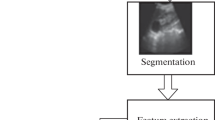Abstract
A novel automated classification technique for diagnosing liver disorders is contributed in this paper by utilizing the merits of wavelet and texture features of ultrasound images. In this automated classification technique, initially the diseased part of the ultrasound image is isolated based on the application of improved active contour-based segmentation scheme. Improved active contour-based segmentation is mainly for preventing the issue of worse convergence, which is prevalent in the concave boundary regions of ultrasonic images. After segmentation, shift variant bi-orthogonal wavelet transform is applied for decomposing the region of focus into diagonal, vertical and horizontal component images. This shift variant bi-orthogonal wavelet transform is used in this approach for reducing the degree of prediction errors that are most possible in the classical discrete wavelet transform schemas. Finally, an improved random forest classifier (IRFC) is used for classifying the features that are extracted from the wavelet filtered images using gray level run length matrix (GLRLM). The performance of this scheme is evaluated based on sensitivity, specificity and accuracy metrics and shows the comparison of each classifier performance. The results of the proposed scheme infer an overall classification accuracy rate of 97.8% and confirm better results using GLRLM.





Similar content being viewed by others
References
Alivar A, Daniali H, Helfroush MS (2014) Classification of liver diseases using ultrasound images based on feature combination. In Computer and Knowledge Engineering (ICCKE), 2014 4th International eConference on IEEE 669–672
Alivar A, Danyali H, Helfroush MS (2016) Hierarchical classification of normal, fatty and heterogeneous liver diseases from ultrasound images using serial and parallel feature fusion. Biocybernet Biomed Eng 36(4):697–707
Balaji GN, Subashini TS, Chidambaram N (2016) Detection and diagnosis of dilated cardiomyopathy and hypertrophic cardiomyopathy using image processing techniques. Eng Sci Technol Int J 19(4):1871–1880
Bolon-Canedo V, Sanchez-Marono N, Alonso-Betanzos A (2011) Feature selection and classification in multiple class datasets: an application to KDD cup 99 dataset. Expert Syst Appl 8(5):5947–5957
Hall MA (1999) Correlation-based feature selection for machine learning
Hwang YN, Lee JH, Kim GY, Jiang YY, Kim SM (2015) Classification of focal liver lesions on ultrasound images by extracting hybrid textural features and using an artificial neural network. Biomed Mater Eng 26(s1):S1599–S1611
Ibrahim HE, Badr SM, Shaheen MA (2012) Adaptive layered approach using machine learning techniques with gain ratio for intrusion detection systems. arXiv preprint arXiv:1210.7650
Kalyan K, Jakhia B, Lele RD, Joshi M, Chowdhary A (2014) Artificial neural network application in the diagnosis of disease conditions with liver ultrasound images. Advances in bioinformatics
Kitamura T, Takeuchi S, Abe S (2010) Feature selection and fast training of subspace based support vector machines. In Neural Networks (IJCNN), The 2010 International Joint Conference on IEEE 1–6
Krishnan KR, Sudhakar R (2013) Automatic classification of liver diseases from ultrasound images using GLRLM texture features. In Soft Computing Applications Springer, Berlin, Heidelberg 611–624
Owjimehr M, Danyali H, Helfroush MS, Shakibafard A (2017) Staging of fatty liver diseases based on hierarchical classification and feature fusion for back-scan–converted ultrasound images. Ultrason Imaging 39(2):79–95
Rastghalam R, Pourghassem H (2016) Breast cancer detection using MRF-based probable texture feature and decision-level fusion-based classification using HMM on thermography images. Pattern Recogn 51:176–186
Sabih D, Hussain M (2012) Automated classification of liver disorders using ultrasound images. J Med Syst 36(5):3163–3172
Singh M, Singh S, Gupta S (2014) An information fusion based method for liver classification using texture analysis of ultrasound images. Inform Fusion 19:91–96
Siri SK, Latte MV (2018) Universal Liver Extraction Algorithm: An Improved Chan–Vese Model. Journal of Intelligent Systems
Thangaparvathi B, Anandhavalli D, Shalinie SM (2011) A high speed decision tree classifier algorithm for huge dataset. In Recent Trends in Information Technology (ICRTIT), 2011 International Conference on IEEE 695–700
Uddin MS, Halder KK, Tahtali M, Lambert AJ, Pickering MR (2015) Speckle reduction and deblurring of ultrasound images using artificial neural network. In Picture Coding Symposium (PCS) 105–108
Venkatalakshmi K, MercyShalinie S (2004) Classification of multispectral images using neuro-statistical classifier based on decision fusion and feature fusion. In Intelligent Sensing and Information Processing, 2004. Proceedings of International Conference on. IEEE 283–288
Virmani J, Kumar V, Kalra N, Khandelwa N (2013) PCA-SVM based CAD system for focal liver lesions using B-mode ultrasound images. Def Sci J 63(5):478
Zaim A, Yi T, Keck R (2007) Feature-based classification of prostate ultrasound images using multiwavelet and kernel support vector machines. In Neural Networks, 2007. IJCNN 2007. International Joint Conference on IEEE 278–281
Zhu W, Zeng N, Wang N (2010) Sensitivity, specificity, accuracy, associated confidence interval and ROC analysis with practical SAS implementations. NESUG Proc: Health Care Life Sci Baltimore Maryland 19:67
Author information
Authors and Affiliations
Corresponding author
Additional information
Publisher’s Note
Springer Nature remains neutral with regard to jurisdictional claims in published maps and institutional affiliations.
Rights and permissions
About this article
Cite this article
Rani Krithiga, R., Lakshmi, C. A novel automated classification technique for diagnosing liver disorders using wavelet and texture features on liver ultrasound images. Multimed Tools Appl 79, 3761–3773 (2020). https://doi.org/10.1007/s11042-018-7045-7
Received:
Revised:
Accepted:
Published:
Issue Date:
DOI: https://doi.org/10.1007/s11042-018-7045-7




